Xiaotian Li
GAFusion: Adaptive Fusing LiDAR and Camera with Multiple Guidance for 3D Object Detection
Nov 01, 2024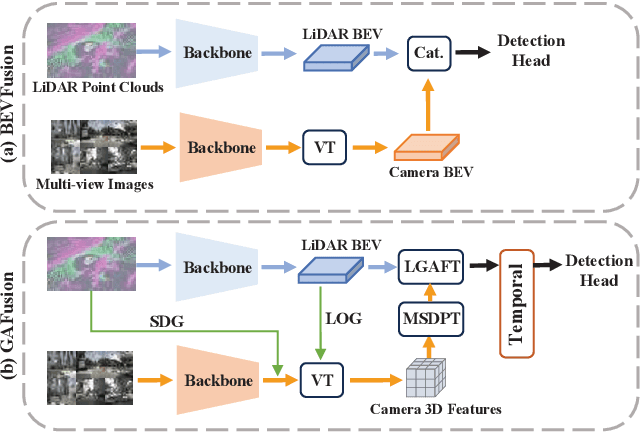
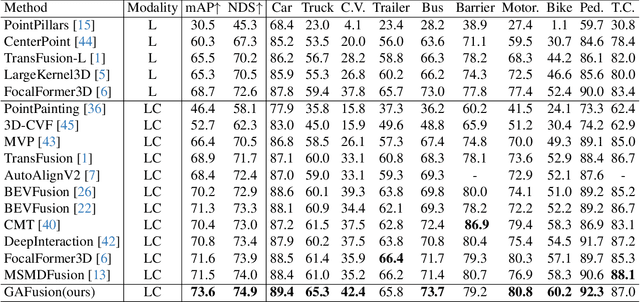
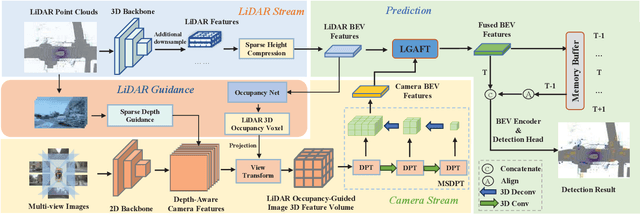
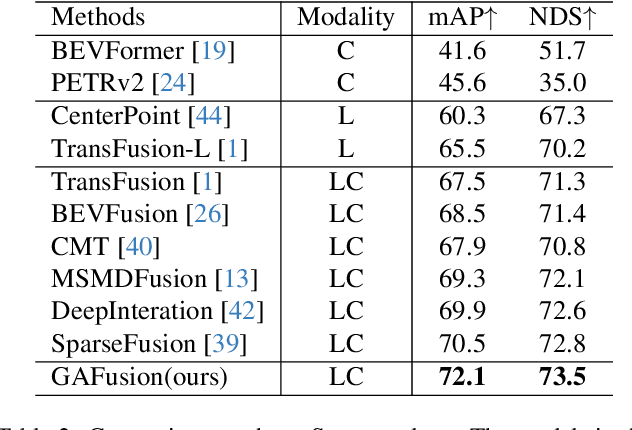
Abstract:Recent years have witnessed the remarkable progress of 3D multi-modality object detection methods based on the Bird's-Eye-View (BEV) perspective. However, most of them overlook the complementary interaction and guidance between LiDAR and camera. In this work, we propose a novel multi-modality 3D objection detection method, named GAFusion, with LiDAR-guided global interaction and adaptive fusion. Specifically, we introduce sparse depth guidance (SDG) and LiDAR occupancy guidance (LOG) to generate 3D features with sufficient depth information. In the following, LiDAR-guided adaptive fusion transformer (LGAFT) is developed to adaptively enhance the interaction of different modal BEV features from a global perspective. Meanwhile, additional downsampling with sparse height compression and multi-scale dual-path transformer (MSDPT) are designed to enlarge the receptive fields of different modal features. Finally, a temporal fusion module is introduced to aggregate features from previous frames. GAFusion achieves state-of-the-art 3D object detection results with 73.6$\%$ mAP and 74.9$\%$ NDS on the nuScenes test set.
The Diversity Bonus: Learning from Dissimilar Distributed Clients in Personalized Federated Learning
Jul 22, 2024



Abstract:Personalized Federated Learning (PFL) is a commonly used framework that allows clients to collaboratively train their personalized models. PFL is particularly useful for handling situations where data from different clients are not independent and identically distributed (non-IID). Previous research in PFL implicitly assumes that clients can gain more benefits from those with similar data distributions. Correspondingly, methods such as personalized weight aggregation are developed to assign higher weights to similar clients during training. We pose a question: can a client benefit from other clients with dissimilar data distributions and if so, how? This question is particularly relevant in scenarios with a high degree of non-IID, where clients have widely different data distributions, and learning from only similar clients will lose knowledge from many other clients. We note that when dealing with clients with similar data distributions, methods such as personalized weight aggregation tend to enforce their models to be close in the parameter space. It is reasonable to conjecture that a client can benefit from dissimilar clients if we allow their models to depart from each other. Based on this idea, we propose DiversiFed which allows each client to learn from clients with diversified data distribution in personalized federated learning. DiversiFed pushes personalized models of clients with dissimilar data distributions apart in the parameter space while pulling together those with similar distributions. In addition, to achieve the above effect without using prior knowledge of data distribution, we design a loss function that leverages the model similarity to determine the degree of attraction and repulsion between any two models. Experiments on several datasets show that DiversiFed can benefit from dissimilar clients and thus outperform the state-of-the-art methods.
MOFA: A Model Simplification Roadmap for Image Restoration on Mobile Devices
Aug 24, 2023



Abstract:Image restoration aims to restore high-quality images from degraded counterparts and has seen significant advancements through deep learning techniques. The technique has been widely applied to mobile devices for tasks such as mobile photography. Given the resource limitations on mobile devices, such as memory constraints and runtime requirements, the efficiency of models during deployment becomes paramount. Nevertheless, most previous works have primarily concentrated on analyzing the efficiency of single modules and improving them individually. This paper examines the efficiency across different layers. We propose a roadmap that can be applied to further accelerate image restoration models prior to deployment while simultaneously increasing PSNR (Peak Signal-to-Noise Ratio) and SSIM (Structural Similarity Index). The roadmap first increases the model capacity by adding more parameters to partial convolutions on FLOPs non-sensitive layers. Then, it applies partial depthwise convolution coupled with decoupling upsampling/downsampling layers to accelerate the model speed. Extensive experiments demonstrate that our approach decreases runtime by up to 13% and reduces the number of parameters by up to 23%, while increasing PSNR and SSIM on several image restoration datasets. Source Code of our method is available at \href{https://github.com/xiangyu8/MOFA}{https://github.com/xiangyu8/MOFA}.
HSCNet++: Hierarchical Scene Coordinate Classification and Regression for Visual Localization with Transformer
May 05, 2023Abstract:Visual localization is critical to many applications in computer vision and robotics. To address single-image RGB localization, state-of-the-art feature-based methods match local descriptors between a query image and a pre-built 3D model. Recently, deep neural networks have been exploited to regress the mapping between raw pixels and 3D coordinates in the scene, and thus the matching is implicitly performed by the forward pass through the network. However, in a large and ambiguous environment, learning such a regression task directly can be difficult for a single network. In this work, we present a new hierarchical scene coordinate network to predict pixel scene coordinates in a coarse-to-fine manner from a single RGB image. The proposed method, which is an extension of HSCNet, allows us to train compact models which scale robustly to large environments. It sets a new state-of-the-art for single-image localization on the 7-Scenes, 12 Scenes, Cambridge Landmarks datasets, and the combined indoor scenes.
Weakly-Supervised Text-driven Contrastive Learning for Facial Behavior Understanding
Mar 31, 2023Abstract:Contrastive learning has shown promising potential for learning robust representations by utilizing unlabeled data. However, constructing effective positive-negative pairs for contrastive learning on facial behavior datasets remains challenging. This is because such pairs inevitably encode the subject-ID information, and the randomly constructed pairs may push similar facial images away due to the limited number of subjects in facial behavior datasets. To address this issue, we propose to utilize activity descriptions, coarse-grained information provided in some datasets, which can provide high-level semantic information about the image sequences but is often neglected in previous studies. More specifically, we introduce a two-stage Contrastive Learning with Text-Embeded framework for Facial behavior understanding (CLEF). The first stage is a weakly-supervised contrastive learning method that learns representations from positive-negative pairs constructed using coarse-grained activity information. The second stage aims to train the recognition of facial expressions or facial action units by maximizing the similarity between image and the corresponding text label names. The proposed CLEF achieves state-of-the-art performance on three in-the-lab datasets for AU recognition and three in-the-wild datasets for facial expression recognition.
Multimodal Learning with Channel-Mixing and Masked Autoencoder on Facial Action Unit Detection
Sep 25, 2022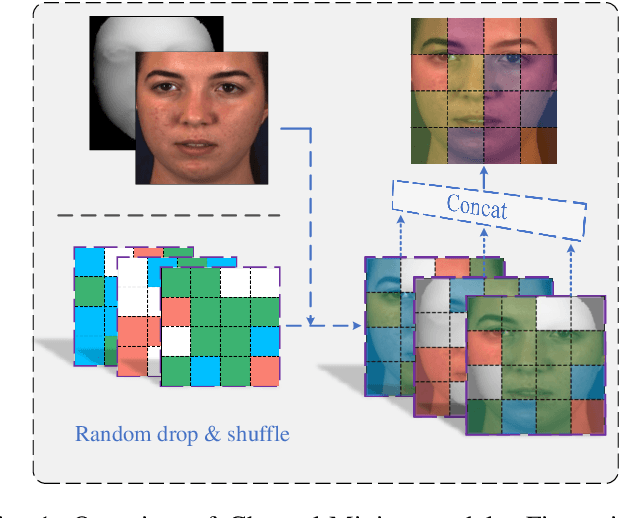

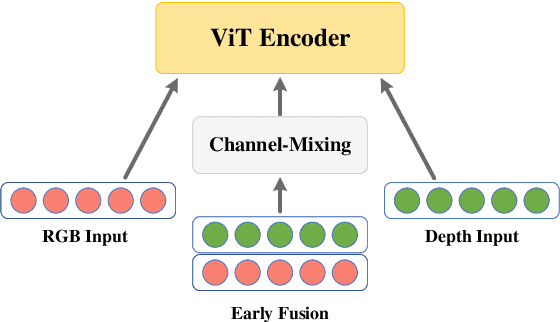
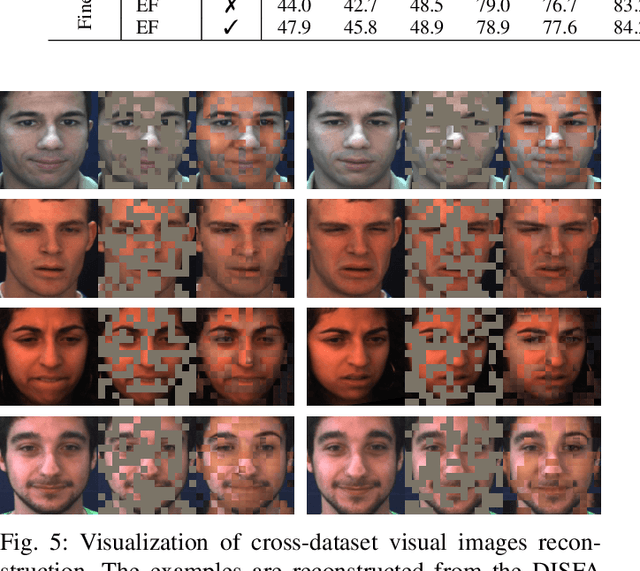
Abstract:Recent studies utilizing multi-modal data aimed at building a robust model for facial Action Unit (AU) detection. However, due to the heterogeneity of multi-modal data, multi-modal representation learning becomes one of the main challenges. On one hand, it is difficult to extract the relevant features from multi-modalities by only one feature extractor, on the other hand, previous studies have not fully explored the potential of multi-modal fusion strategies. For example, early fusion usually required all modalities to be present during inference, while late fusion and middle fusion increased the network size for feature learning. In contrast to a large amount of work on late fusion, there are few works on early fusion to explore the channel information. This paper presents a novel multi-modal network called Multi-modal Channel-Mixing (MCM), as a pre-trained model to learn a robust representation in order to facilitate the multi-modal fusion. We evaluate the learned representation on a downstream task of automatic facial action units detection. Specifically, it is a single stream encoder network that uses a channel-mixing module in early fusion, requiring only one modality in the downstream detection task. We also utilize the masked ViT encoder to learn features from the fusion image and reconstruct back two modalities with two ViT decoders. We have conducted extensive experiments on two public datasets, known as BP4D and DISFA, to evaluate the effectiveness and robustness of the proposed multimodal framework. The results show our approach is comparable or superior to the state-of-the-art baseline methods.
Knowledge-Spreader: Learning Facial Action Unit Dynamics with Extremely Limited Labels
Mar 30, 2022

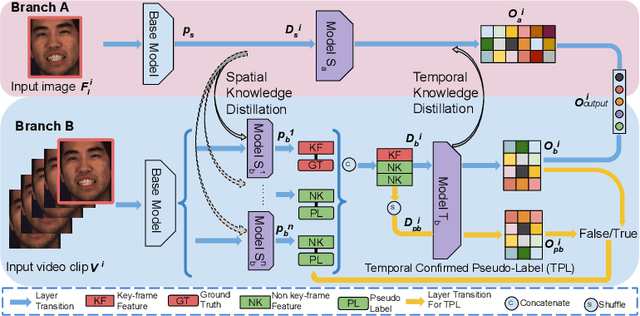
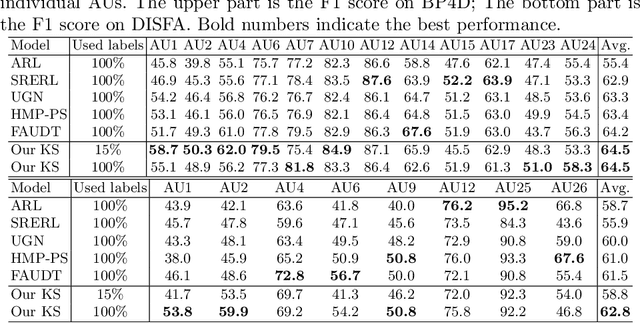
Abstract:Recent studies on the automatic detection of facial action unit (AU) have extensively relied on large-sized annotations. However, manually AU labeling is difficult, time-consuming, and costly. Most existing semi-supervised works ignore the informative cues from the temporal domain, and are highly dependent on densely annotated videos, making the learning process less efficient. To alleviate these problems, we propose a deep semi-supervised framework Knowledge-Spreader (KS), which differs from conventional methods in two aspects. First, rather than only encoding human knowledge as constraints, KS also learns the Spatial-Temporal AU correlation knowledge in order to strengthen its out-of-distribution generalization ability. Second, we approach KS by applying consistency regularization and pseudo-labeling in multiple student networks alternately and dynamically. It spreads the spatial knowledge from labeled frames to unlabeled data, and completes the temporal information of partially labeled video clips. Thus, the design allows KS to learn AU dynamics from video clips with only one label allocated, which significantly reduce the requirements of using annotations. Extensive experiments demonstrate that the proposed KS achieves competitive performance as compared to the state of the arts under the circumstances of using only 2% labels on BP4D and 5% labels on DISFA. In addition, we test it on our newly developed large-scale comprehensive emotion database, which contains considerable samples across well-synchronized and aligned sensor modalities for easing the scarcity issue of annotations and identities in human affective computing. The new database will be released to the research community.
An EEG-Based Multi-Modal Emotion Database with Both Posed and Authentic Facial Actions for Emotion Analysis
Mar 29, 2022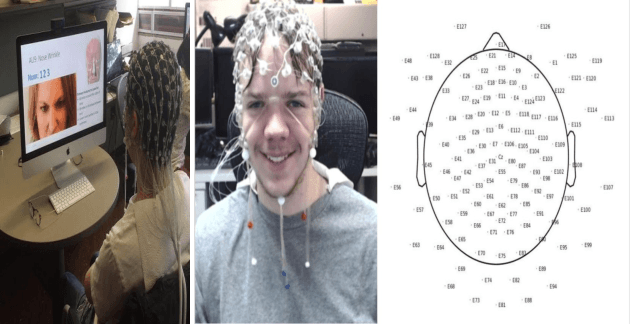
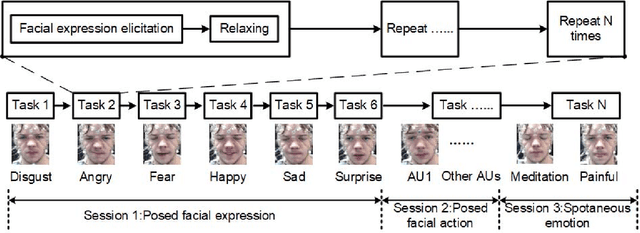
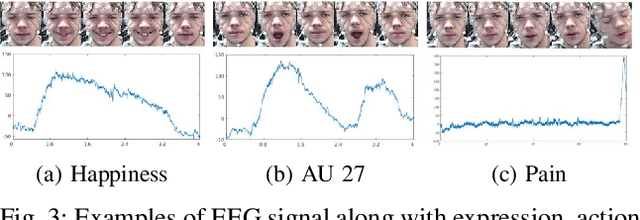
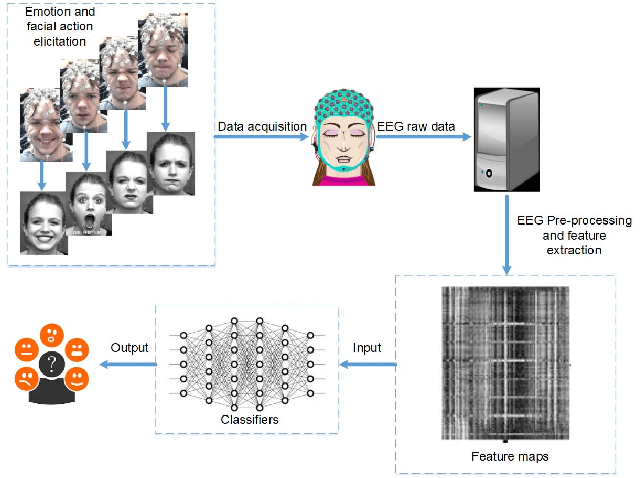
Abstract:Emotion is an experience associated with a particular pattern of physiological activity along with different physiological, behavioral and cognitive changes. One behavioral change is facial expression, which has been studied extensively over the past few decades. Facial behavior varies with a person's emotion according to differences in terms of culture, personality, age, context, and environment. In recent years, physiological activities have been used to study emotional responses. A typical signal is the electroencephalogram (EEG), which measures brain activity. Most of existing EEG-based emotion analysis has overlooked the role of facial expression changes. There exits little research on the relationship between facial behavior and brain signals due to the lack of dataset measuring both EEG and facial action signals simultaneously. To address this problem, we propose to develop a new database by collecting facial expressions, action units, and EEGs simultaneously. We recorded the EEGs and face videos of both posed facial actions and spontaneous expressions from 29 participants with different ages, genders, ethnic backgrounds. Differing from existing approaches, we designed a protocol to capture the EEG signals by evoking participants' individual action units explicitly. We also investigated the relation between the EEG signals and facial action units. As a baseline, the database has been evaluated through the experiments on both posed and spontaneous emotion recognition with images alone, EEG alone, and EEG fused with images, respectively. The database will be released to the research community to advance the state of the art for automatic emotion recognition.
Your "Attention" Deserves Attention: A Self-Diversified Multi-Channel Attention for Facial Action Analysis
Mar 23, 2022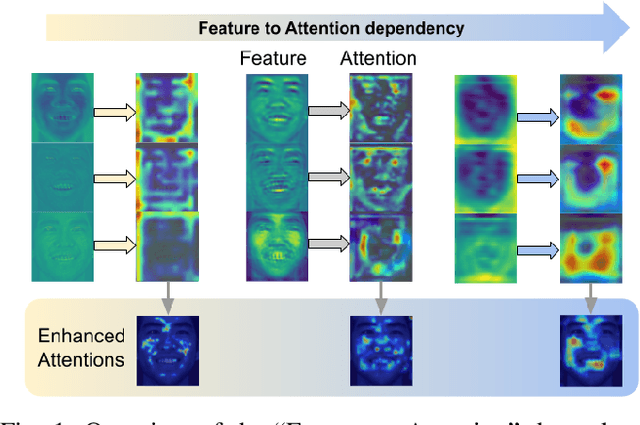
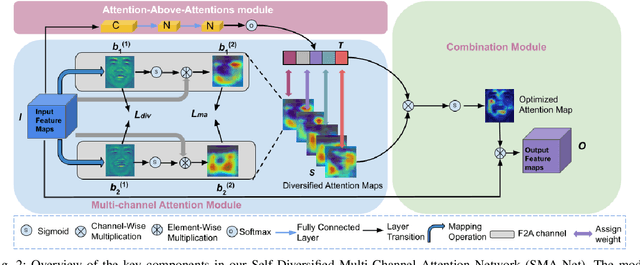
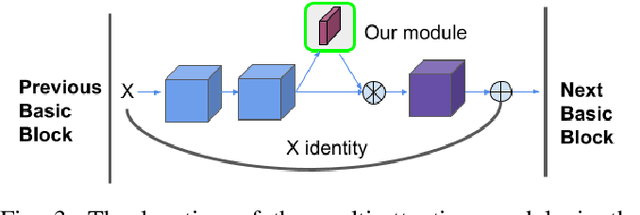
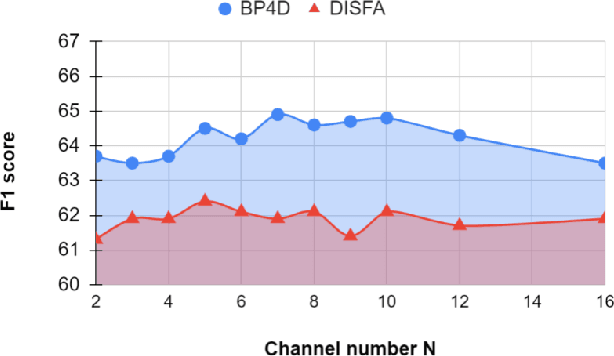
Abstract:Visual attention has been extensively studied for learning fine-grained features in both facial expression recognition (FER) and Action Unit (AU) detection. A broad range of previous research has explored how to use attention modules to localize detailed facial parts (e,g. facial action units), learn discriminative features, and learn inter-class correlation. However, few related works pay attention to the robustness of the attention module itself. Through experiments, we found neural attention maps initialized with different feature maps yield diverse representations when learning to attend the identical Region of Interest (ROI). In other words, similar to general feature learning, the representational quality of attention maps also greatly affects the performance of a model, which means unconstrained attention learning has lots of randomnesses. This uncertainty lets conventional attention learning fall into sub-optimal. In this paper, we propose a compact model to enhance the representational and focusing power of neural attention maps and learn the "inter-attention" correlation for refined attention maps, which we term the "Self-Diversified Multi-Channel Attention Network (SMA-Net)". The proposed method is evaluated on two benchmark databases (BP4D and DISFA) for AU detection and four databases (CK+, MMI, BU-3DFE, and BP4D+) for facial expression recognition. It achieves superior performance compared to the state-of-the-art methods.
Digging Into Self-Supervised Learning of Feature Descriptors
Oct 10, 2021



Abstract:Fully-supervised CNN-based approaches for learning local image descriptors have shown remarkable results in a wide range of geometric tasks. However, most of them require per-pixel ground-truth keypoint correspondence data which is difficult to acquire at scale. To address this challenge, recent weakly- and self-supervised methods can learn feature descriptors from relative camera poses or using only synthetic rigid transformations such as homographies. In this work, we focus on understanding the limitations of existing self-supervised approaches and propose a set of improvements that combined lead to powerful feature descriptors. We show that increasing the search space from in-pair to in-batch for hard negative mining brings consistent improvement. To enhance the discriminativeness of feature descriptors, we propose a coarse-to-fine method for mining local hard negatives from a wider search space by using global visual image descriptors. We demonstrate that a combination of synthetic homography transformation, color augmentation, and photorealistic image stylization produces useful representations that are viewpoint and illumination invariant. The feature descriptors learned by the proposed approach perform competitively and surpass their fully- and weakly-supervised counterparts on various geometric benchmarks such as image-based localization, sparse feature matching, and image retrieval.
 Add to Chrome
Add to Chrome Add to Firefox
Add to Firefox Add to Edge
Add to Edge